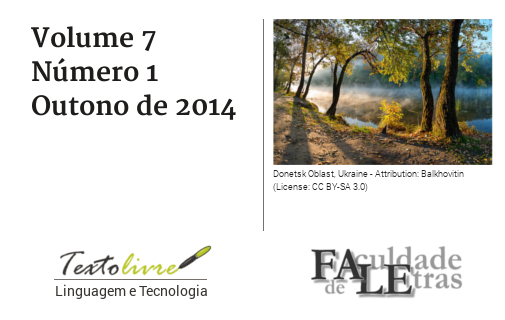A escrita em inglês como sistema adaptativo complexo: o desenvolvimento da fluência, precisão e complexidade gramatical por meio das TIC
DOI:
https://doi.org/10.17851/1983-3652.7.1.49-67Palabras clave:
Sistemas adaptativos complexos. Interlíngua. Habilidade escrita. Língua Inglesa.Resumen
Na procura por uma abordagem que tratasse a aprendizagem de línguas de uma forma mais global e dinâmica, linguistas aplicados como Larsen-Freeman (1997) e Paiva (2005) recorreram às teorias do Caos/Complexidade como metáfora para tratar desse processo. Nessa perspectiva, defende-se que aprender uma língua é um sistema adaptativo complexo, porque reúne todas as suas características: é aberto, sensível a fatores externos e a condições iniciais, imprevisível, não-linear, regido por regras de baixo nível e auto-organizável. Esta pesquisa foi investigar o desenvolvimento da interlíngua em duas alunas de um curso de Licenciatura em Letras – Habilitação em Língua Inglesa – de uma universidade federal em um blog. Foram analisadas fluência, precisão e complexidade gramatical dos textos publicados além do trabalho colaborativo realizado.
Descargas
Referencias
BERTALANFFY, L. V. Teoria geral dos sistemas. Petrópolis: Vozes, 1973.
BOHN, V. C. R. How the web 2.0 can help teachers in English language teaching: some suggestions. 2007. 36 f. Monografia (Bacharelado em Língua Inglesa) - Faculdade de Letras da Universidade Federal de Minas Gerais, Belo Horizonte, 2007.
CHOMSKY, N. 'Review of “Verbal Behavior” by B. F. Skinner.' Language. 35, 1, 1959. p. 26-58 apud LIGHTBOWN, P.; SPADA N. How languages are learned. Oxford: Oxford University Press, 1993.
ELLIS, R. Second language acquisition. Oxford: Oxford University Press, 1997.
ELLIS, R.; BARKHUIZEN, G. Analysing Learner Language. Oxford: Oxford University Press, 2005.
FERREIRA, A. S. Interações em Curso de Inglês Instrumental mediado pelo computador: expectativas e resultados. 1998. Dissertação (Mestrado em Linguística Aplicada e Estudos da Linguagem) - Pontifícia Universidade Católica de São Paulo, São Paulo, 1998.
HUNT, W. Grammatical Structures at Three Levels. Michigan University: National Council of Teachers of English, 1965 apud ELLIS, R.; BARKHUIZEN, G. Analysing Learner Language. Oxford: Oxford University Press, 2005.
KRASHEN, S. Principles and Practice in Second Language Acquisition. London: Prentice-Hall International (UK) Ltd., 1981. _______. The Input Hipothesis: Issues and Implications. London: Longman, 1985.
LARSEN-FREEMAN, D.; LONG, M. An Introduction to Second Language Acquisition Research. New York: Longman, 1991.
LARSEN-FREEMAN, D. Chaos/complexity science and second language acquisition. Applied Linguistics. Oxford, v. 2, n. 18, 1997. p.141-165.
LARSEN-FREEMAN, D.; CAMERON, L. Research methodology on language development from a complex systems perspective. Modern Language Journal. Malden, MA, n. 92 v.2, 2008. p. 200- 213.
LENNEBERG, E. Biological Foundations of Language. New York: Wiley, 1967 apud SELINKER, L. Interlanguage. IRAL. Boston, MA, v.10, n. 3, 1972. p. 209-231.
LEVY, M. Computer-assisted language learning. Oxford: Oxford University Press, 1997.
LEWIN, R. Complexidade: a vida no limite do caos. Tradução de Marta Rodolfo Schmidt. Rio de Janeiro: Rocco, 1994.
LIGHTBOWN, P.; SPADA N. How languages are learned. Oxford: Oxford University Press, 1993.
LONG, M. Input and Second Language Acquisition Theory. In: GASS, S.; MADDEN, C. Input in second language acquisition. Rowley, Mass: Newbury House. 1985. p. 377-393 apud LIGHTBOWN, P.; SPADA N. How languages are learned. Oxford: Oxford University Press, 1993.
MOZZILLO, I. La Interlengua: producto del contactolingüístico en clase de lengua extranjera. Caderno de Letras. Universidade Federal de Pelotas, v. 11, n. 11, 2005. p. 65-75.
NUNES, G. A escrita em inglês como sistema adaptativo complexo: uma abordagem colaborativa na aprendizagem de língua estrangeira por meio das TIC. 2013. Dissertação (Mestrado – Programa de Pós-Graduação em Letras), Universidade Federal de Pelotas, Pelotas, 2013. 100 p.
PAIVA, V. L. M. O. A www e o ensino de Inglês. Revista Brasileira de Linguística Aplicada. Belo Horizonte, v. 1, n.1, 2001. p. 93-116. _______. Modelo fractal de aquisição de línguas. In: BRUNO, F.C. (Org.) Reflexão e Prática em ensino/aprendizagem de língua estrangeira. São Paulo: Editora Clara Luz, 2005. p. 23-36.
RUEGG, R. Interlanguage Development: The Effect of Unfocused Feedback on L2 Writing. Intercultural Communication Studies XIX. Kanda University of International Studies, 1, 2010. p. 247-254.
SELINKER, L. Interlanguage. IRAL. Boston, MA, v.10, n. 3, 1972. p. 209-231.
SKINNER, B. Verbal Behavior. New York: Appleton-Century-Crofts, 1957.
VAN LIER, L. Interaction in the Language Curriculum: Awareness, Autonomy, and Authencity. London: Longman,1996 apud PAIVA, V. L. M. O. A www e o ensino de Inglês. Revista Brasileira de Linguística Aplicada. Belo Horizonte, v. 1, n.1, 2001. p. 93-116.
VETROMILLE-CASTRO, R. Considerações sobre grupos em ambientes virtuais de aprendizagem como sistemas complexos. Revista Brasileira de Linguística Aplicada. Belo Horizonte, v. 8, n. 1, 2008. p. 211-234.
VYGOTSKY, L.S. A formação social da mente: o desenvolvimento dos processos psicológicos superiores. Tradução de José Cipolla Neto. 4. ed. São Paulo: Martins Fontes, 1991.
WEINREICH, U. Languages in contact: Findings and Problems. Mouton De Gruyter. 1963. WOLFE-QUINTERO, K.; INAGAKI, S.; HAE-YOUNG, K. Second Language Development in Writing: Measures of Fluency, Accuracy and Complexity. Honolulu. HI: University of Hawai’i Press. 1998.
Descargas
Publicado
Número
Sección
Licencia
Este es un artículo de acceso abierto que permite su uso, distribución y reproducción sin restricciones en cualquier medio siempre que se cite correctamente el artículo original.











